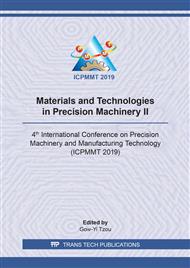p.53
p.59
p.69
p.77
p.85
p.93
p.101
p.107
p.113
Finite Element Prediction of Temperature Variation of Material and Dies in Aluminum Forging
Abstract:
Investigation into behaviors of aluminum alloy to be metal formed at the room temperature is conducted in this study. An index is used to evaluate the sensitivity of temperature, that is, index of relative normalized temperature rise to steel called normalized temperature rise index per steel which helps researchers to obtain some insight on new materials based on experiences of steel forging. An investigation to an aluminum alloy shows that the index is quite high, implying that temperature effect as well as rate-dependence effect on the forming processes of aluminum alloy at the room temperature cannot be neglected. Some details of thermomechanical predictions of a relatively high-speed automatic multi-stage forging process of a yoke with highly deformed region are given to reveal the importance of temperature and/or strain rate even in cold forging of aluminum alloy parts with high speed and high strain.
Info:
Periodical:
Pages:
93-100
Citation:
Online since:
February 2020
Authors:
Price:
Сopyright:
© 2020 Trans Tech Publications Ltd. All Rights Reserved
Share:
Citation:


